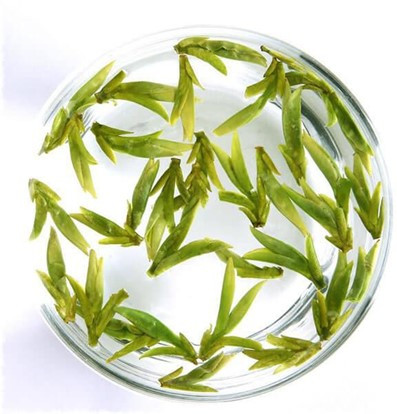Dragon Well Green Tea | Bangladesh
Dragon Well (Lung Ching) Green Tea

An
Introduction to Dragon Well Green Tea
By Md. Rashidul Islam |
Halda Valley Tea Estate, Bangladesh
Lung Ching Dragonwell tea leaves are collected in small baskets and taken for processing.
China’s national drink is Lung Ching (Long Jing) Dragonwell green tea. It is cultivated and processed in Hangzhou in Zhejiang province, China. Lung Ching tea comes from a well near the West Lake in Hangzhou. When it rains, it is said that the rainwater on the surface of the well creates ripples that look like Chinese dragons swimming through the water.
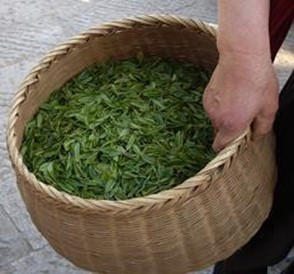
For tea to be called Lung Ching, it must originate from the Hangzhou area of Zhejiang province. There are teas from other regions of China that are prepared in the same way but are usually only known as Lung Ching Style tea. There are many grades of Lung Ching tea, with one of the finest grades known as Pre-Qingming Lung Ching. This tea is harvested before the Qingming festival, around the 5th of April each year - also known as pre-rain Lung Ching. The finest grades of Lung Ching are usually sent to the government instead of the growers paying financial taxes on their revenues.
Lung Ching has a distinctive appearance with flat brittle bright green leaves, and the flavor is also unique because of how it is processed by pressing the leaves against a hot surface. The earlier picked leaves are usually lighter in color with pointy tips and sometimes have small white lumps on them. These lumps result from the fine hairs that grow on the leaf buds clumping together during the processing.
The picked tea is collected in small baskets and taken to one of the local processors. Here it is laid out in wicker trays for several hours. After this, the tea undergoes two rounds of pressing with a break in between for drying in the air.
Enjoying a glass of Lung Ching at one of the cafes on the shores of the West Lake, Hangzhou
The first pressing round is carried out using a machine that presses the leaves against a boiling surface. After the first pressing, the leaves are rested in wicker baskets in the open air before undergoing a second pressing. The second pressing is carried out by hand, and it is this pressing that requires the skill of a tea master who can tell when the tea is ready. Next, the tea leaves are pressed by hand against the hot surface of a wok-like bowl that has been oiled with tea seed oil to stop the leaves from sticking. The heat is lower than that of the first pressing and is more commonly generated with electricity, although many tea masters still use burning wood.
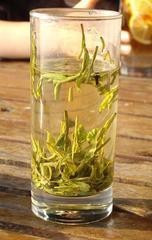
The Longjing Tea (Dragon Well Tea) is world-famous for its ‘four wonders’ - emerald, green color, aromatic flavor, sweet taste, and beautiful appearance. Because of its nutritional value and extraordinary effect on people’s health, it is favored by both the domestic and foreign markets.
The History and Legend of Dragon Well Green Tea
As legend has it, Emperor Qianlong had been south of the Yangtze River six times, while he went to the Dragon Well area four times to observe the tea-picking process. Then, having tasted the tea and composed poetry about its beauty in person, Emperor Qianlong awarded the eighteen tea bushes to Hangzhou Shifeng Mountain Royal Tea. Because of this renown, for a time, Hangzhou Shifeng became a mecca for all, with delicately beautiful mountains and crystal clear water, making it a popular destination in China.
Production Area
Dragon Well Tea flourishes in the mountainous area with a mild climate and plentiful rainfall year-round. Around West Lake, Shifeng Peak, Longjing Village, Yunxi Mountain, Hupao, and Meijiawu Tea Plantation offer such prime conditions. The history of planting tea trees is rather long in these areas, as the tea sage Lu Yu mentioned in his Book of Tea. The teas grown in these areas were called Shi, Long, Yun, Hu, and Mei, respectively, in the past. With increased production, it is generally classified into Xihu (West Lake) Longjing, Qiantang Longjing, and Yuezhou Longjing, among which the Xihu Longjing is the best.
Production Process
A super elaborate production process guarantees the excellent quality of Dragon Well Tea. The picking of the leaves emphasizes the importance of timeliness. A famous saying among tea growers is, “Tea leaves are a treasure if picked earlier, while it is useless as grass if picked too late.” Dragon Well Tea leaves are picked during different periods. Generally speaking, the best is selected before Qingming Festival, which is called Mingqian Tea. The ones chosen before Grain Rain are good and called Yuqian Tea. The selection process for tea leaves is rigorous. Only the delicate and complete leaves are to be picked. After the fresh leaves have been selected, the makers should first sort and grade them, as different qualities of leaves require different temperatures and techniques. Then, the masters will bake the tea by hand using specially made iron pans. The traditional method of making Dragon Well Tea has many ways - grasp, toss, shake, pile, throw, buckle, press, and grind.
Experienced masters know how and when to use specific movements according to the leaves’ temperature, color, and moisture content. Usually, Longjing is graded using a scale of six levels from superior quality to low quality. This is because different groups of tea have other methods of baking.
Flavor and Appearance
Dragon Well is a beautiful tea; the dry leaves are smooth, flattened, and spear-like, with the lighter colors representing better grades of Dragon Well. The dry leaves present a delicately delicate aromatic, mellow, sweet fragrance.
The Longjing tea was lovely, with the sweetness most evident in the finish and aftertaste. The main body of the tea is equal parts savory and sweet, with the savory side hinting at grainy, nutty, and, yes, even green bean flavors.
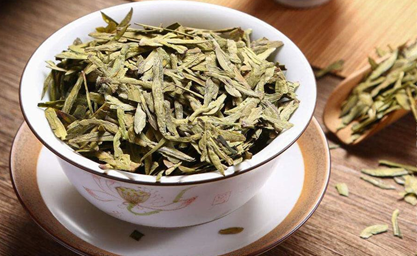
The Production Flowchart
The first step of processing is to extend the leaves in a bamboo basket, put it in a shady place for 8-10 hours, let the wind take away about 30% water in the leaves, and get rid of the scent of grass.
The second step is to roast the tea leaves in a specially-made electronic steel pan. When its temperature turns 80-100oC, put about 250g tea leaves into it and then roast for 20 minutes. This roasting is done by hand all the time. Tea masters are proficient in traditional roasting Longjing Tea - grasp, toss, shake, pile, throw, buckle, press, and grind, called “8 Hand Movements”, a set of complex roasting skills. Experienced tea masters know how and when to use specific movements according to tea leaves’ temperature, color, and moisture content. A novice takes three years to master that, and they roast at only one kilogram a day.
Roasting reduces the percentage of water in tea leaves to about 10%. So the third process step is to extend them in a bamboo basket to cool down, or what we can call this resurgence, which takes 40-60 minutes.
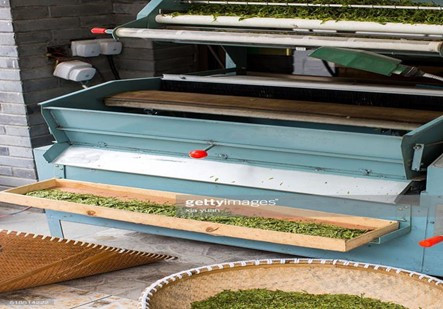
Fixation (Kill-green)
After cooling, we must examine the tea, screen them, and remove the broken pieces. And roast the good ones again in the pan at 60-70oC. The second roasting costs 20-25 minutes until it reduces the tea leaves water percentage to about 5%. Till now, the Longjing tea leaves are ready to make a great cup of Longjing tea.
Proper Storage of Dragon Well Green Tea
Proper storage of Dragon Well green tea is of the utmost importance in keeping it at its freshest and most flavorful. When first purchasing a high-grade Dragon Well Longjing green tea, the first taste of it is delicate and exquisite. However, unless stored properly, Dragon Well green tea will degrade quickly in quality over days.
Using a suitable canister is a significant factor in proper tea storage. Ideally, the canister should be opaque, not be able to absorb odors, and have an air-tight lid. When adding new tea to the canister for the first time, shake some fresh tea around and store the package or loose tea inside the canister. Ensure the canister or container has a very tight lid so air cannot permeate the canister.
Tea must also be stored far away from the kitchen or other moist or humid places, such as near dryer vents, dishwasher vents, or other areas where tea can absorb moisture. As mentioned above, canisters for storing tea should be dark so that sunlight can not degrade the tea. Canisters should also be moisture-proof and placed in an area away from any dampness which can cause oxidization, mold, or mildew in tea. If tea does take on any moisture, discard it immediately. The fridge is also a better choice.
How to make the perfect Dragon Well tea
Step 1: Use one teaspoon per cup.
Step 2: Use water that has cooled to 80 degrees; adding freshly boiled water to green tea will cause the taste to be bitter!
Step 3: Brew for 90 seconds or longer, according to personal taste.
Step 4: Green tea is best without milk & can be re-steeped 3-5 times
The Health Benefits of Dragon Well Tea
Dragon Well green tea includes 3.7% of amino acids, 12.1% of catechins, 4.0% of Caffeine, 18.5% of Camellia sinensis (Tea Polyphenols), and Vitamin C and other trace minerals, vitamins, and antioxidants. As a result, the nutritional value of Dragon Well green tea is more than that of many other green teas, which is what makes Dragon Well tea such a powerhouse of nutritional benefits and helps to keep your body healthy and free of toxins.
Kazi & Kazi Tea Estate Ltd. in Dhaka, Bangladesh, is a pioneer 100% organic tea producer in Bangladesh, producing & distributing tea to local & international markets.
